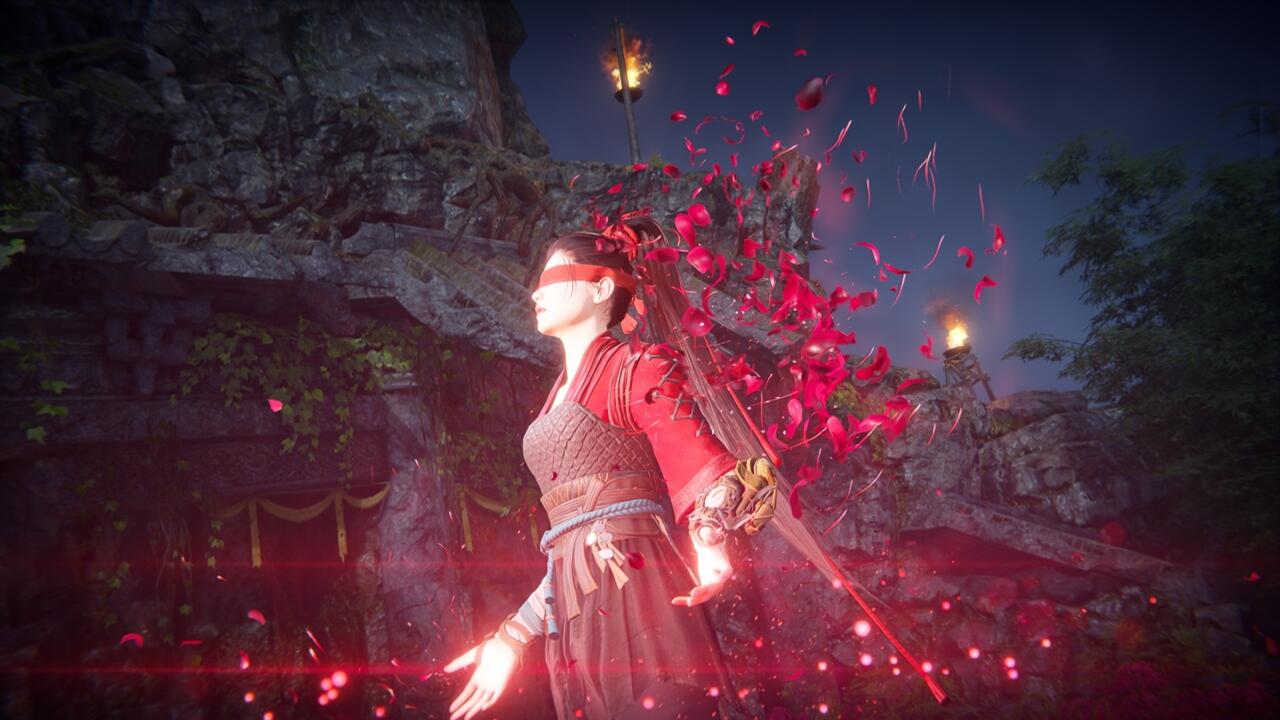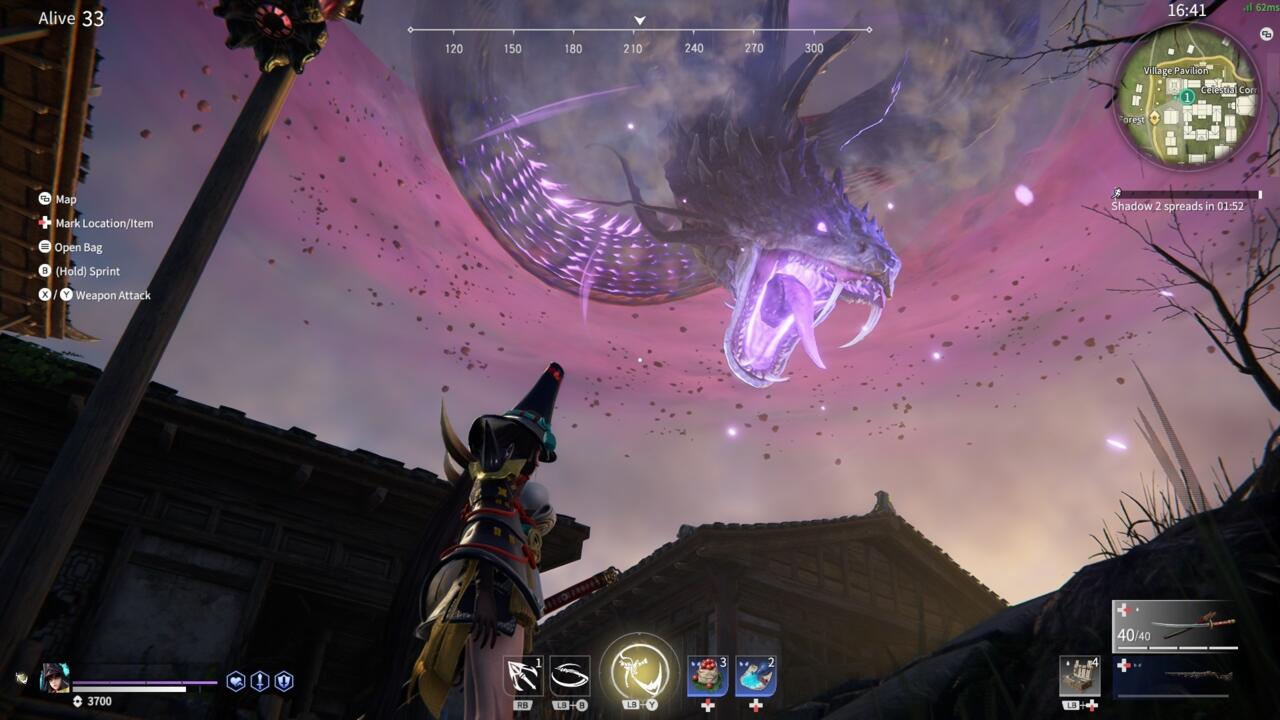If absolutely nothing else, be grateful to Naraka Bladepoint for being one of a scant few battle royale titles where getting one-shotted by someone hiding in a shrub three football fields away isn't a danger. That by itself makes it welcoming in a way the genre tends to ignore. But lurking beneath that relative ease and approachability is a shrewd game of wuxia-inspired combat that demandsfar more steelfrom its players--and we're not just talking about swords and spears.
The basic premise of Naraka Bladepoint involves a secret island where warring gods once battled to their deaths, and warriors now battle for the smallest part of the gods' power. But that story all but evaporates after the tutorial stage, aside from some skimpy lore cards for each character unlocked after reaching a certain XP level. All you really need to know is you're on an island of abandoned villages, scattered weapon caches, and an undulating purple wall of death that ushers 60 brave warriors closer and closer together. Your sole mission is to be the last person standing, by any and all means necessary.
Survival means combat, but instead of the usual pistols/shotguns/assault rifles, you're primarily looking at melee weapons. Ranged options do exist, from crossbows and slow-firing muskets to environmental hazards that can be triggered by the right slice or shot at the right time. You also have a grappling hook that not only allows you to zip across the map and onto higher ground, but also harpoon and fly at opponents Attack on Titan-style.Aside from the hook, each ranged option exists to merely soften up opponents from a distance as they close in. Getting the big fat kill involves getting up close and personal with something sharp, and here, showdowns with opponents have more in common with Dynasty Warriors and SoulCalibur than Fortnite.
Each weapon has a number of melee combos, fancy uppercuts, charge maneuvers, and parries, which is augmented by power-up shards of jade you can either find or purchase while out in the field. While button-mashing the first enemy you see works when you're starting out (there are currently bots thrown in with actual players to ease you in at first) your first encounter with a player who knows what they're doing will teach you some brutal lessons.
You start learning that your parry has a Sekiro-like margin of success, and even that's predicated on a poorly-explained color system that tells you if your character has the ability to parry a specific attack altogether. Dodges are effective, but can be easily adjusted for by a smart, forward-thinking player. You'll even run into the dreaded mechanic of weapons and armor degradation, which sounds like the dealbreaker on paper. However, repair items are widespread, and the push and pull of every player--regardless of how skilled they are--needing to find respite in order to be successful creates a rather nice tension to every match. You're dealing with all of this while also wondering if the next warrior to finish you off hasn't been waiting in the trees for you the whole time. Everyone is vulnerable here, as long as you catch them at the right moment.

That's a solid and exciting foundation to build a battle royale game onto, but like most games of the sort there's a lot of overhead room to grow. There are a few nitpicks with the game as a set of mechanics. The control scheme, in particular, occupies an awkward middle ground where actual combat is best with a controller, but equipping/switching items and managing your loadout damn near requires a mouse and keyboard. And switching back and forth effectively feels awkward, no matter how you decide to configure the layout.There are only a few game modes at the moment: a typical Battle Royale Mode, with an option for Apex Legends-style Trio matches included, and a free-for-all Deathmatch mode. That’s typically fine for a game that has more going on mechanically or narratively to keep you engaged, but that's just not where the game is at right now, and the grind can get a little rote as a result.
Right now, the game's biggest issue is one of personality. The world of Morus Island is absolutely gorgeous, a place of sun-kissed golden valleys, haunting shipwrecks, and derelict temples.There are more than a few moments so painterly, and evocative of Chinese mythology and ancient art I had to stop in my tracks to appreciate them, which typically resulted in someone I didn’t see deciding to try and snag a free hit. The environment of the game is very much on point as far as immersion goes.However, characters are a different case. With only two exceptions--the blind swordswoman Viper Ning, and the possessed witch Yoto Hime--the warriors of Morus Island are rather generic martial artists whose personalities don't shine through, visually or mechanically. Each does have their own set of special moves and an Ultimate ability, but many of them are unwieldy in a hectic fight, at least until you've stuck it out with them enough to unlock the far more effective enhanced versions of those moves. There is some level of skin customization, where you can adjust a hero's face and costumes to an extent, but because there isn't really a reason to care about these people, you're stuck making flimsy cosmetic changes. Most of the options for those changes are locked behind--you guessed it--a loot system, where there are multiple currencies, none of which are fully explained, and the most effective way to earn them comes from spending real money.

Naraka Bladepoint's UI is already a cluttered mess of things you don't and shouldn't worry yourself about until you've put several hours into the game, but once you've put in the time to try and understand, you realize just how much of the information boils down to "here are ways to spend coins, and you'll need a lot of them." The good news is that this doesn't apply to anything that would make winning matches any easier, as you get XP no matter what, and leveling up to unlock each character's alternate moves is fairly quick. The bad news is having to wade through all the other noise to do so.
There are issues for sure, but this early in, Naraka Bladepoint has room to grow and iron out its kinks. You can see the potential more than the problems when you're in the thick of it, grappling from rooftop to rooftop, clanging swords with enemies, drums and wind instruments filling the air as you consider the best way to move in for the kill.There’s a forethought and shrewdness required to be successful here that gives it a very different feel than any other battle royale title that’s out there at the moment, and the ancient Chinese aesthetic is a dazzling one. If nothing else, it’s enough to want to see what the game looks and feels like in the months to come.









